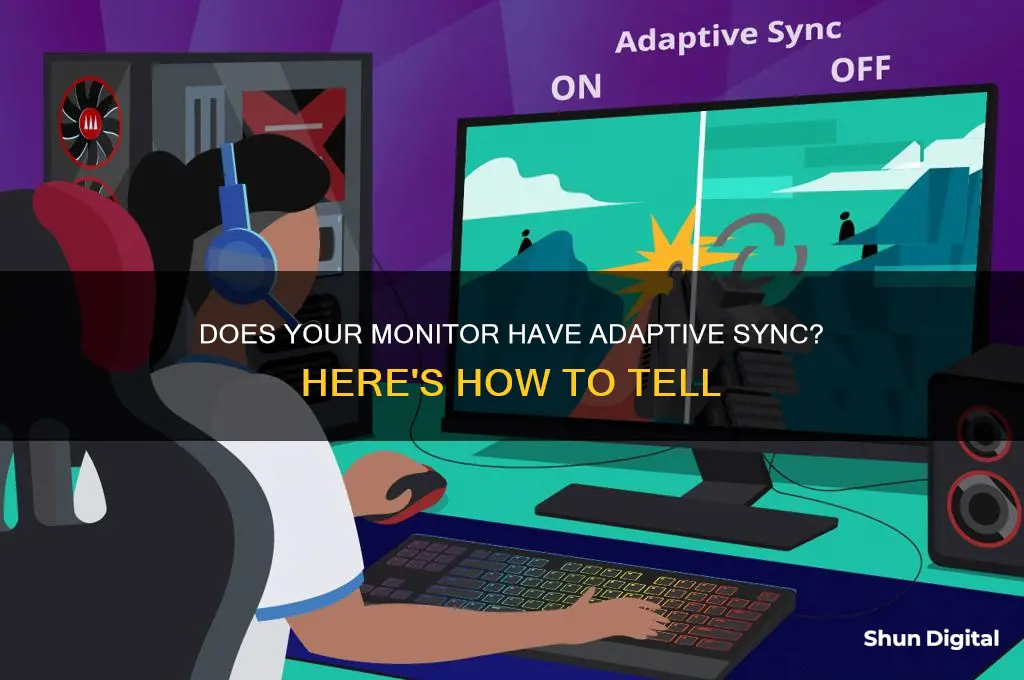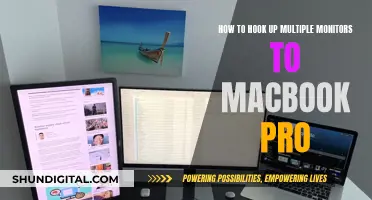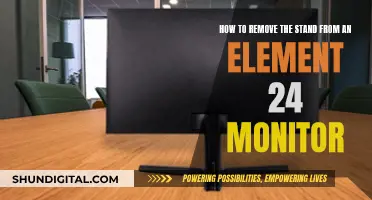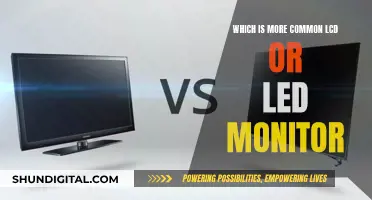
Adaptive sync is a technology that helps to synchronise the frame rate of a graphics card with the refresh rate of a monitor, eliminating screen tearing and minimising game stuttering. It is particularly useful for gaming, where different scenes demand varying levels of frame rates. A display with adaptive sync can change its refresh rate in response to how fast your graphics card is pumping out frames. This results in smooth, consistent motion without screen tearing.
| Characteristics | Values |
|---|---|
| Purpose | To prevent screen tearing and game stuttering for a smoother gameplay experience |
| How it works | Adjusts the display's refresh rate to match the GPU's outputting frames |
| Benefits | No more buffering, freezing or slowdowns during scene transitions |
| Smooth, consistent motion without screen tearing | |
| Reduced input lag | |
| Reduced power consumption | |
| Improved fluidity | |
| Smoother gameplay | |
| No screen tears | |
| Eliminates juddering effect caused by V-Sync | |
| Can be used for seamless video playback at various frame rates | |
| Limitations | May introduce additional input lag |
| Requires compatible hardware |
What You'll Learn
- Adaptive Sync prevents screen tearing and game stuttering
- It syncs the monitor's refresh rate with the graphics card's frame rate
- V-Sync caps the GPU's frame rate to the monitor's refresh rate
- AMD FreeSync and Nvidia G-Sync are based on VESA Adaptive Sync
- Adaptive Sync can also be used for seamless video playback

Adaptive Sync prevents screen tearing and game stuttering
To understand how Adaptive Sync prevents screen tearing and game stuttering, it is important to first understand what these issues are and why they occur.
Screen Tearing
Traditional monitors refresh their images at a fixed rate. However, when a game demands higher frame rates outside of the set range, especially during fast-motion scenes, the monitor might not be able to keep up. This results in the monitor displaying parts of multiple frames simultaneously, creating a noticeable split or "tear" across the screen.
For example, if your game is running at 90 FPS (Frames Per Second) but your monitor's refresh rate is 60Hz, your graphics card is updating 90 times per second while the display can only manage 60. This overlap leads to split images, detracting from the viewing experience and hampering gameplay.
Game Stuttering
Game stuttering or micro-stuttering occurs when frames are repeated, skipped, or frozen. This is often due to input delay between the GPU and the display, causing games to feel slow and laggy. Players experience delayed actions and sudden screen hiccups.
Input lags are commonly caused by a decrease in FPS when the GPU renders images at a slower rate compared to the monitor. When the frame rate drops below the display's refresh rate, game stuttering and input delays can occur.
How Adaptive Sync Helps
Adaptive Sync is a technology that addresses these issues by dynamically adjusting the monitor's refresh rate to match the frame rate output by the graphics card. This synchronization between the monitor and the graphics card results in a smoother, more fluid visual performance, particularly during fast-paced video games or high-motion video playback.
The graphics card communicates its current frame rate to the monitor, which then continuously adjusts its refresh rate to match. This ensures that each frame from the graphics card is synced with the display's refresh, preventing screen tearing and reducing stuttering.
In addition to improving the gaming experience, Adaptive Sync can also enhance video playback by enabling seamless transitions at various frame rates. It also reduces power consumption by matching the monitor's refresh rate to the video content's frame rate.
Hooking Up Your GameCube to an ASUS Monitor
You may want to see also

It syncs the monitor's refresh rate with the graphics card's frame rate
Adaptive sync is a technology that synchronizes the refresh rate of a monitor with the frame rate output from the graphics card, ensuring that they are always matched. This technology helps to eliminate screen tearing and stuttering, which can occur when the monitor and graphics card are out of sync.
Screen tearing is a visual artifact that happens when the display device (the monitor) shows information from multiple frames in a single screen draw. This creates a torn or split-screen effect, with the image appearing to be torn or ripped, and is particularly noticeable during fast-paced or high-motion scenes in games or videos. On the other hand, stuttering occurs when the frame rate of the graphics card does not match the refresh rate of the monitor, leading to a choppy or uneven display.
By synchronizing the refresh rate and frame rate, adaptive sync technology ensures that the monitor only updates the image when a new frame is ready from the graphics card. This eliminates the possibility of screen tearing and reduces stuttering, providing a smoother and more seamless visual experience.
The two main types of adaptive sync technologies are FreeSync and G-Sync. FreeSync, developed by AMD, is an open standard that is license-free and widely adopted by monitor manufacturers. It allows the monitor to dynamically adjust its refresh rate to match the frame rate output by the graphics card. G-Sync, created by NVIDIA, works similarly to FreeSync but uses proprietary hardware and software and is generally more expensive. Both technologies require a compatible monitor and graphics card to function properly.
Removing the Bezel from Your ASUS Monitor: A Step-by-Step Guide
You may want to see also

V-Sync caps the GPU's frame rate to the monitor's refresh rate
V-Sync, or Vertical Sync, is a graphics technology designed to synchronise a game's frame rate with the refresh rate of a gaming monitor. It caps or limits the frame rate output of the graphics card (GPU) to the monitor's refresh rate, preventing the GPU from feeding the display more information than it can handle.
For example, if a game is running at 90 FPS (Frames Per Second) but your monitor's refresh rate is 60Hz, V-Sync will limit the graphics card's output to 60 FPS, preventing the monitor from displaying a split image or a 'tear' across the screen.
V-Sync is featured in most modern graphics cards and is enabled on a monitor through the settings of either the graphics card manufacturer's software (e.g. Nvidia Control Panel or AMD FreeSync) or on a per-game basis through the graphics settings menu of the game itself.
While V-Sync is a useful feature to prevent screen tearing, it can also negatively affect gaming performance by reducing the frame rate and increasing input lag. This is especially noticeable in fast-paced games that require quick reactions, such as first-person shooters and fighting games.
Asus Monitor: Website Ordering Worth It?
You may want to see also

AMD FreeSync and Nvidia G-Sync are based on VESA Adaptive Sync
VESA Adaptive Sync was developed by VESA, a standards body responsible for DisplayPort, which added variable refresh as an optional part of the specification. This created a standardised and royalty-free means of enabling variable refresh displays. AMD was the first to support this standard, advertising it under their FreeSync branding. Nvidia later followed suit, supporting VESA Adaptive Sync on GeForce cards and allowing gamers access to a wider array of variable refresh monitors.
AMD FreeSync utilises VESA's royalty-free technology to sync the refresh rate to the FPS. It works on most monitors, which helps to keep prices down. However, AMD has left the framerate range in the hands of the manufacturers, which reduces the usefulness of the sync technology.
Nvidia G-Sync uses the same principle as Adaptive Sync but relies on proprietary hardware that must be built into the display. With the additional hardware and strict regulations enforced by Nvidia, monitors supporting G-Sync have tighter quality control and are more premium in price.
Both AMD FreeSync and Nvidia G-Sync ultimately aim to provide smooth gameplay on compatible displays. They solve the problem of screen tearing by allowing a display to change its refresh rate in response to how fast the graphics card is pumping out frames.
Transforming LCD Monitors: TV Conversion Without a Tuner
You may want to see also

Adaptive Sync can also be used for seamless video playback
Adaptive Sync is a display technology that helps to smoothen visuals by synchronizing the monitor's refresh rate with the outputting frame rates of the GPU. This technology is especially useful for gaming monitors, as it ensures smooth gameplay by preventing screen tearing and reducing lags and stuttering. However, Adaptive Sync can also be used outside of gaming to enable seamless video playback.
When watching videos, the monitor's refresh rate and the content's frame rate need to be synchronized to avoid visual artifacts like video stutters. Adaptive Sync adjusts the monitor's refresh rate to match the frame rate of the video content, ensuring smooth and seamless playback. This technology is beneficial for videos with different frame rates, ranging from 23.98 to 60 fps.
For example, if you are watching a movie with a 60 fps playback speed, your monitor needs to be able to refresh at 60 frames per second to display the video without any issues. Without Adaptive Sync, if the monitor's refresh rate is lower than the content's frame rate, it will result in stuttering and freezing. Adaptive Sync eliminates these problems by dynamically changing the monitor's refresh rate to match the frame rate of the video, ensuring smooth and uninterrupted playback.
In addition to improving the viewing experience, Adaptive Sync also helps to reduce power consumption. By matching the monitor's refresh rate to the content's frame rate, the monitor uses only the necessary power to display the video, resulting in reduced power consumption. This makes Adaptive Sync a useful feature not only for gamers but also for anyone who wants to enjoy seamless video playback on their devices.
To enable Adaptive Sync on your device, you can go to the GPU's control center and change the display settings. It is supported on Windows PCs with compatible hardware and newer Macs. By turning on Adaptive Sync, you can improve your video playback experience and enjoy smooth and seamless visuals.
Fixing the ViewSonic VA 1930WM LCD Monitor: A Step-by-Step Guide
You may want to see also
Frequently asked questions
Adaptive sync is a technology that helps to eliminate screen tearing and reduce game stuttering and input lag by synchronising the monitor’s refresh rate with the graphics card’s frame rate.
Screen tearing occurs when a monitor refreshes at its set rate (usually 60Hz) and the refresh lands between two frames, resulting in parts of both frames being displayed at the same time.
Game stuttering or micro-stuttering occurs when frames are repeated, skipped, or frozen, often due to input delay between the GPU and the display.
V-Sync, or Vertical Sync, is a technology that locks the frame rate of a game to the refresh rate of a display, eliminating screen tearing but also capping the game's performance.
V-Sync caps the GPU's frame rate to match the display's refresh rate, while Adaptive Sync dynamically changes the monitor's refresh rate to match the game's required frame rate, eliminating screen tearing and the juddering effect caused by V-Sync.







